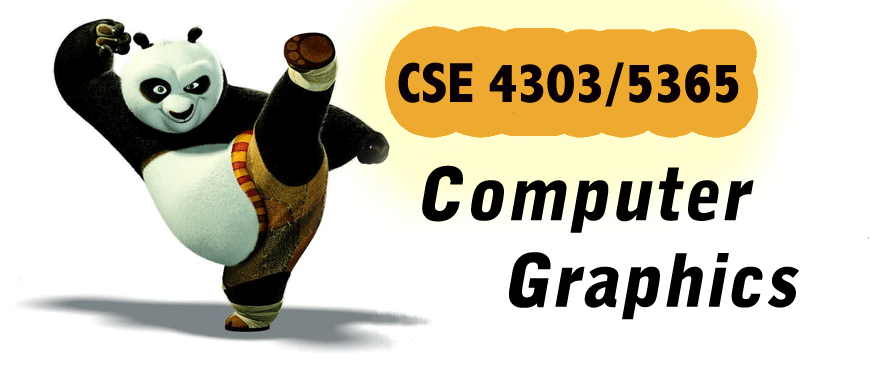
"Super cute CG animals can only be created with your kung-fu computer graphics skillz" -- Andries van Dam
CSE 4303/5365 Computer Graphics (Spring 2012)
Computer Science and Engineering
Dr. Heng Huang
|
[ Administrative Basics |
Course Description |
Assignments |
Syllabus ]
Administrative Basics
Lecture
|
ERB 103 | Tuesdays and Thursdays 6:30PM - 7:50PM
|
Instructor
|
Heng Huang | ERB 533 | Office hours: Mondays and Wednesdays 2pm - 4pm
|
Textbook
|
- Required:
- Shirley et al., Fundamentals of Computer Graphics, Third Edition, 2009.
- Optional:
- OpenGL programming Guide (5th Edition) (red book).
|
Work
|
Three homework sets. (30%)
Three assignments. (40%)
Mid-term exam. (10%)
Final exam. (20%)
|
Request
|
JAVA programming background, basic math.
|
Co-Instructor
|
Dijun Luo | Office hours: 11:00am - 1:00pm Tuesday and Thursday, ERB 409 | dijun.luo@gmail.com
|
Course Description
The Computer Graphics course will help students study the programming and mathematical foundations of modeling and rendering 3D scenes. Topics will include digital image representation, geometrical transformations, illumination and shading models, and visible surface algorithms. The students will be required to finish a mixture of written homeworks and short programming assignemnts.
Assignments
Homeworks
The class will have triweekly homeworks consisting of a few short problems,
where you will be required to work out numerical problems or answer short question.
Homework 1 Due on Feb. 14, please hand in your homework before class. Solution
Homework 2 Due on Mar. 6, please hand in your homework before class.
Homework 3 Due on Apr. 26, please hand in your homework before class.
Programming assignments
The class will also require you to perform four simple programming assignments. The entire programming framework will be given in JAVA.
You are to perform the assignments in Java using the basic code provided in class
and email your results to both heng@uta.edu and dijun.luo@gmail.com , unless otherwise noted.
Assignments are typically due at 11:59 pm of the due date.
Exams
The course will have a midterm and a final exams covering the material taught in class.
Syllabus
- Week 1
- Jan. 17: Introduction (slides)
Shirley, Ch. 1.1-1.7
A basic introduction to computer graphics and some practicalities for implementing the algorithms. Please ignore the C++ descriptions.
- Jan. 19: Images and Displays I (slides)
Shirley, Ch. 3.1-3.4
A very basic introduction to digital images and compositing.
- Week 2
- Jan. 24: Images and Displays II (slides)
Shirley, Ch. 3.1-3.4
A very basic introduction to digital images and compositing.
- Jan. 26: Raytracing I (slides)
Shirley, Ch. 4.1-4.4, 4.6, 4.7
Basic raytracing: viewing rays generation, object intersection(sphere, triangle and polygon), shadows, reflection and refraction. We will not cover in detail the ray-polygon intersection.
- Week 3
- Jan. 31: Lighting and Surface Shading (slides)
Ch. 4.5, 4.8, 10.1, 10.2, 13.1
Basic surface shading with a difression on non-photorealistic models for art and illustration.
- Week 4
- Feb. 7: 2D Transformations, 3D Transformations (slides)
Shirley, Ch. 5
Linear algebra review. Don't bother too much about inverse computation, eigenvalues and SVD.
Shirley, Ch. 6
2D geometric transformations.
Shirley, Ch. 6
3D geometric transformations.
- Feb. 9: 3D Viewing (slides)
Shirley, Ch. 7
Viewing transformations. Do not try to memorize the matrices given, but concentrate on the concepts introduced. We will be looking at a simpler version of the matrices in class, so this chapter is good to look at the full formulation.
- Week 5
- Feb. 14: Meshes (slides)
Shirley, Ch. 12.1
A quick introduction to some of the common mesh data structures.
- Feb. 16: Spline Curves (slides)
- Week 6
- Feb. 21: Parametric Surfaces and Solid Modeling
Good reference is Foley et al. if you want to know more.
Not covered in Shirley
Zorin and Schroder, Ch. 1-3
A very in-depth course on subdivision surfaces. You sould only skim trhough this quickly. A full copy of the course can be found at
http://mrl.nyu.edu/publications/subdiv-course2000/.
- Feb. 23: Parametric Surfaces and Solid Modeling (slides)
- Week 7
- Feb. 28: Subdivision Surfaces (slides)
- Mar. 1: Animation I (slides)
Shirley, Ch. 17
- Week 8
- Week 9
- Week 10
- Mar. 20: Animation II (slides)
Shirley, Ch. 17
- Mar. 22: Scene Graphs (slides)
Shirley, Ch. 13.3
- Week 11
- Mar. 27: Sampling and Reconstruction (slides)
Shirley, Ch. 4.1-4.4
- Mar. 29: Texture Mapping (slides)
Shirley, Ch. 11
An introduction to texturing; covers more details on 3d textures than we have done in class.
- Week 12
- Apr. 3: Graphics Pipeline I (slides)
Shirley, Ch. 8, Ch. 12.4
An introduction to the various algorithms used in the graphics pipeline.
- Apr. 5: Graphics Pipeline II (slides)
Shirley, Ch. 8, Ch. 12.4
An introduction to the various algorithms used in the graphics pipeline.
Antialiasing and Compositing
(Not covered much in Shirley)
Original [Porter and Duff 1984] paper
Java program based on Porter-Duff algorithm
- Week 13
- Apr. 10: Ray Tracing II (slides)
Shirley, Ch. 12.3, 12.4, 13.2
Support for hierarchies and sub-linear intersection for raytracing.
- Apr. 12: Monte Carlo Integration (slides)
Shirley, Ch. 14
Introduction to Monte Carlo integration.
- Week 14
- Apr. 17: Distribution Ray Tracing (slides)
Shirley, Ch. 13.4
- Apr. 19: Advanced Solid Modeling (slides)
Not in Shirley's book
- Week 15
- Apr. 24: No Class, instructor will attend RECOMB conference
- Apr. 26: Rendering Equation and Color Science (slides)
Introduction to the rendering equation and reflection models. Uses a notation very different than ours that might be a bit confusing in some places.
Introduction to global illumination methods. Goes into more details on how to accurately compute direct lighting.
Shirley, Ch. 25
Shirley, Ch. 19, Ch. 24
Shirley, Ch. 20
- Week 16
- Week 17
|